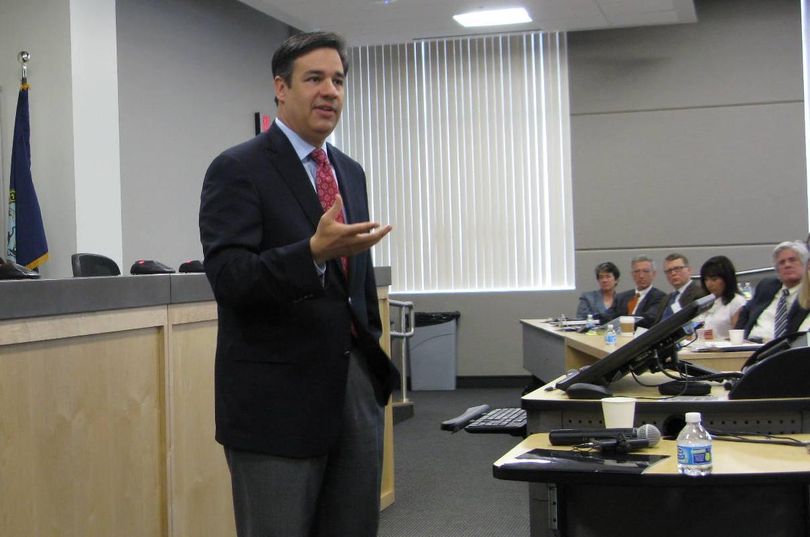Labrador: Momentum building for sentencing reform

Here’s my full story from spokesman.com:
By Betsy Z. Russell
BOISE – Idaho GOP Congressman Raul Labrador says momentum is building in Congress for major criminal justice reforms, aimed at reversing decades of focus on long prison terms that even hit non-violent and first-time offenders.
“I believe that we’re going to see some of the greatest reforms in a generation,” Labrador told a criminal justice reform conference at Concordia University School of Law in Boise on Monday. “Momentum is building for reform. This Congress alone, I’ve already met with President Obama twice. … This is actually one area that I think I can work with the president.”
Labrador, a Republican and tea party favorite, last year co-sponsored major, bipartisan reform legislation, but it didn’t advance; this year, a less ambitious bill is pending in both houses that includes some of the same provisions, including giving judges more discretion on whether to impose mandatory minimum sentences. “We only have 5 percent of the world’s population in the United States, and the U.S. is home to 25 percent of the world’s prison population,” Labrador said. “We should not be proud of that.”
That bill and several others have cleared the House Judiciary Committee, Labrador said, “and House Speaker Paul Ryan has expressed his support for the movement and has promised me to bring a reform package to the floor for a vote this year.” However, it hasn’t happened yet, and Labrador acknowledged that hopes are fading as more of the year passes by. “It’s a little bit watered down,” he said. “They had to look at the political reality, what can pass in the Senate and the House.”
Still, he pledged to continue to push the issue, one that Labrador, an immigration and criminal defense attorney, said he started work on as soon as he arrived in Congress.
James Piotrowski, Labrador’s Democratic challenger and a Boise attorney, said, “Certainly some of the reforms he’s talking about are things that are needed and that I agree with. … We’re certainly glad to have Rep. Labrador on board.” He added, "We can't just reform criminal justice if we don’t also address the reality that we have to fund the programs that work,and that’s hard to do when we’re dealing with the House’s sequester rules."
The third-term congressman was among an array of speakers at the conference, who also included law professors, experts, federal public defenders and prosecutors, and a high-ranking Justice Department official.
Jonathan Wroblewski, principal deputy assistant Attorney General for the U.S. Department of Justice, shared some history on how the nation got to this point. A dramatic increase in violent crime from 1960 to 1992 led to an even more dramatic increase in incarceration as Congress got tough on crime – far beyond historical incarceration rates in the U.S., and a trend that continued even after crime rates began falling. Today, violent crime rates are back down to pre-1970 levels.
By the recession in 2008, states and the federal government were finding the costs of mass incarceration wildly unsustainable. The justice reinvestment movement – of which Idaho is a part – is now seeking to reduce incarceration rates while still reducing crime. The idea is to reserve long stays in prison for the most violent offenders, and reinvest the savings into programs aimed at better supervising offenders on probation and parole, reducing rates of repeat offenses, and alternate solutions like drug courts.
At the same time, the Justice Department has launched initiatives to limit the use of charges that carry mandatory minimum sentences in cases involving low-risk offenders.
So far, Wroblewski said, it appears to be working. The federal prison population has begun declining for the first time in 30 years; crime rates still are stable or dropping.
The “war on drugs” that led to stiff mandatory minimum sentences enacted in the 1980s – tied not to the circumstances of the crime, but the amount and type of drugs involved – led to huge numbers of non-violent drug offenders serving long prison terms.
“Eighty percent of federal drug prisoners have no history of violence, and more than 25 percent have no criminal history at all,” said Alex Kreit, professor at the Thomas Jefferson School of Law in San Diego and a nationally recognized expert and textbook author on controlled substances and marijuana regulation. “This, in a nutshell, is what is driving interest in federal drug sentencing reform.”
Half of the federal prison population consists of drug offenders, Kreit said, though they comprise only a quarter of those admitted each year. “Part of that is the lengthy drug sentences that we have.”
Though some reforms have happened, notably congressional action in 2010 to reduce the disparity between crack cocaine and powdered cocaine sentences and a 2005 U.S. Supreme Court decision that allowed more discretion in charging drug crimes, as well as the Justice Department’s initiatives, federal drug sentencing laws remain largely unchanged.
Wendy Olson, U.S. Attorney for Idaho, said, “I think there are a lot of people coalescing around the idea that what we have been doing hasn’t worked in the way we wanted it to work. I think all of us in criminal justice have an obligation to look at that.”
U.S. District Judge B. Lynn Winmill said his 28 years on the bench have shown him that the war on drugs has been “an abysmal failure – we certainly have not reduced drug consumption. Whatever has happened, it has not been worth the price that we have paid.”
He said its casualties have largely been low-level drug offenders who were associated with large quantities of drugs – couriers, truck drivers, addicts hired to unload trucks. “Kingpins are almost immune, in the same way that generals and commanders in chief are typically immune during wars,” Winmill said, “and if they are brought down, what happens is that they’re immediately replaced.”
Plus, though African-Americans and Hispanics use drugs at about the same rate as the general population, Winmill said, “The incarceration rate for African-Americans and Hispanics is off the charts. Now, is that implicit bias, is it overt bias, is it a result of a policy from Congress that reflects bias? I don’t know. But I think it certainly is something we need to think long and hard about.”
Said Winmill, who’s been a U.S. District judge for nearly 21 years and the chief judge for the District of Idaho for the past 17 years, “Clearly, the answer lies with Congress.”
